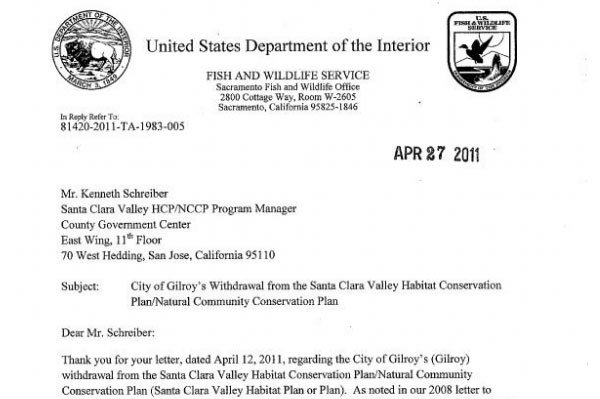Five weeks after saying goodbye to a sprawling, long-term
habitat plan, the Gilroy City Council is doing a double take.
Five weeks after saying goodbye to a sprawling, long-term habitat plan, the Gilroy City Council is doing a double take.
On Monday, the Council will consider how and when the city could rejoin the Santa Clara Valley Habitat Conservation Plan – or if it even wants to be a part of the 50-year, $938 million plan. According to some Council members, the controversial decision to opt out generated a multitude of phone calls, emails and even threats.
“What changed now is some of the collateral damage that could happen,” Mayor Al Pinheiro said.
Some of that damage includes possible dents in plans to expand the South County Regional WasteWater Authority plant, as well as the prospect that federal and state wildlife agencies could “make our lives miserable,” Pinheiro said.
The Council won’t decide on the plan Monday, but will receive a staff report on the consequences for leaving and a timeline for possibly opting back in. The city was given 30 days to return to the plan following an April 8 letter from City Administrator Tom Haglund announcing Gilroy’s intentions to back out. That deadline is May 9, habitat plan program manager Ken Schreiber said, but Gilroy will have until a June 16 habitat plan meeting to officially rejoin or withdraw.
Cay Goude, assistant field supervisor for the U.S. Fish and Wildlife Service’s Sacramento office, requested a meeting between city officials, wildlife agencies and remaining plan partners before Monday’s City Council meeting in an April 27 letter.
As the city ponders whether it could rejoin, however, the plan’s remaining five local agencies are hashing out alternative plans, none of which include the Garlic Capital, Schreiber said.
“There’s many different people saying different things,” Pinheiro said. “It’s really an interesting dilemma. There’s so many players around this table, it’s hard to know who’s telling what.”
Pinheiro and Council members Bob Dillon, Perry Woodward and Dion Bracco voted March 28 to opt out of the plan, which is intended to identify land occupied by endangered or threatened species and streamline the process to obtain permits to build on them.
But the 4-3 vote was “hasty under the circumstances,” Pinheiro said, as the Council looked quickly for a way out because they believed concerns over the project’s fee structures and its affect on Gilroy’s open space would not be addressed. The plan – which includes Morgan Hill, San Jose, Santa Clara County, Santa Clara Valley Water District, Valley Transportation Authority, California Department of Fish and Game and U.S. Fish and Wildlife Service – would also bring an unneeded layer of bureaucracy to the city, some Council members said.
Monday’s slated discussion stems from the April 18 Council meeting at the initial suggestion of Woodward, who said the Council needed to re-examine just when its decision to leave the plan becomes irreversible. Pinheiro and Council members Cat Tucker and Peter Leroe-Muñoz sided with Woodward, and the topic was put on Monday’s agenda.
Like Pinheiro, Woodward said he needed additional facts before following through with the decision to opt out completely.
“I don’t feel pressured to change my decision,” Woodward said. “I think people are trying to engage me about the benefits of being in the plan and drawbacks of leaving the plan.”
Some efforts to reach out to Gilroy have come in the form of threats, several Council members said.
Dillon said the two wildlife agencies have attempted to extort the city, saying if it didn’t rejoin the habitat plan, future Gilroy development needing agency approval would be held up.
“I am extremely unhappy with what is essentially blackmail from the wildlife agencies,” Dillon said last week. “It’s not even a veiled threat.”
But Sarah Swenty, U.S. Fish and Wildlife Service spokeswoman, said a slower approval process was just a reality that Gilroy would face by not participating in the plan. By going it alone, a city’s new project would be stuck at the bottom of the pile, while projects under the umbrella of an already approved habitat plan would face a speedier process from the cash-strapped, short-staffed agencies, Swenty said.
“The city would still be responsible for consulting with the federal government,” she said. “It’s going to slow things down. It’s going to cost more money.”
Don Gage, Santa Clara Valley Water District director, said he had tried to convince Gilroy officials to think twice about opting out, adding he didn’t believe anyone had threatened the city. He agreed staying out of the plan would indeed handicap future Gilroy projects.
“The last guy that calls is the last guy that gets answers. That’s not a threat, that’s just a fact,” Gage said. “These people have been in the cycle, just like we are. A lot of the so-to-speak threats are just realities.”
He said Gilroy could still have opted out at a later time after bringing its concerns to the negotiating table.
“All I can do is tell them. And it’s up to them. It’s their city and its their responsibility and I’m just trying to help them out,” Gage said. “That doesn’t mean they have to stay, but they have to stay long enough to figure out if this is right for them or not.”
Not only could Gilroy face a slower approval process, but the city’s exit from the plan would leave questions over a proposed expansion of the South County Regional WasteWater Authority sewer plant – a Gilroy-Morgan Hill joint effort, Gage said.
“I don’t know how that’s going to work now,” Gage said.
Gilroy City Administrator Tom Haglund said he didn’t think opting out would affect the plant expansion because he was not aware of any implications the project might have on threatened species.
“I don’t know that we have a specific determination on that,” Haglund said. “My thought on the matter is that it shouldn’t have an effect.”
Haglund said expanding the plant would be in line with both cities’ general plans. He said staying out of the habitat plan could be more costly and more time-consuming, but those issues would depend on what types of projects would need approval.
“For some developments it’s probably going to less expensive and time consuming,” he said. “In a way, it’s a bit of a mixed bag.”
Fish and Wildlifevar docstoc_docid=”78200209″;var docstoc_title=”Fish and Wildlife”;var docstoc_urltitle=”Fish and Wildlife”;
var docstoc_docid=”78200210″;var docstoc_title=”Schreiber letter”;var docstoc_urltitle=”Schreiber letter”; Schreiber letter –
var docstoc_docid=”78200212″;var docstoc_title=”Letter to Tom Haglund”;var docstoc_urltitle=”Letter to Tom Haglund”; Letter to Tom Haglund –














